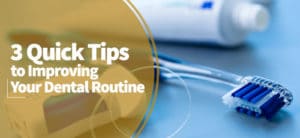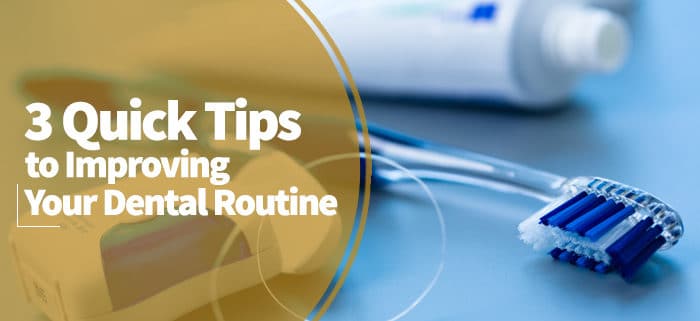
3 QUICK TIPS TO IMPROVING YOUR DENTAL ROUTINE
We don’t always have all the time in the world to improve the health of our teeth. However, just a few minutes a day is all it takes to keep your brilliant smile, plus adopting a few healthy lifestyle habits in between. Check out these three quick tips to improving your dental routine that you can start today.
- Eat Better
A healthy diet and exercise routine isn’t just good for your waistline — it’s good for your smile too. Just as important as brushing and flossing, your diet can have a major impact on the health of your gums and teeth. Instead of reaching for carb-heavy foods that also happen to be high in sugar, go for fruits and vegetables that are packed with nutrients, from apples and bananas to broccoli and kale. Nix the sodas and fruit juices, and teach your kids to do the same. Sugar breeds bacteria in the mouth, leading to decay. In order to keep cavities at bay, start eating healthier and your mouth will thank you for it.
- Switch out your Toothbrush Regularly
Your toothbrush is your friend. However, it’s time to get a new friend every few months or whenever you notice the bristles beginning to fray. You should also get a new one after you’ve been sick with the cold or flu to prevent re-infecting yourself or spreading your germs to others. In a pinch, you can throw your toothbrush in the dishwasher to sanitize it, but this can damage the bristles over time. It’s a good idea to have a new brush waiting in the wings so you always have one on hand.
- Read Toothpaste Labels
Not all toothpaste is created equal. That’s why you should always take a minute to read the labels before buying a tube at the market. You’ll find a lot of the ingredients work to protect the whiteness and sparkle of your teeth, but what are all those other ingredients for? Do you need them?
Here are some you could do without:
- Triclosan: This antibacterial agent is a common addition to many of the most well known toothpaste brands out there, designed to prevent gingivitis. However, studies reveal antibiotic resistance and hormone disruption, while the EPA technically calls this a pesticide.
- Dyes: It’s no secret that synthetic colors and dyes are added to toothpaste to make them look better on the shelf and more appealing to all consumers, particularly kids. These dyes have connections to allergic reactions, behavior difficulties for those with ADHD, asthma attacks, fatigue, headaches and nausea.
- Saccharin: This is an artificial sweetener added to improve the taste of toothpaste, but there has been a link found between cancer and saccharin consumption. It can also bring on allergic reactions, headaches, skin irritation and diarrhea.
- Sodium lauryl sulfate (SLS): This gives soaps and toothpastes their signature bubble and foam. Although it helps dissolve plaque, it can also lead to ulcers and mouth sores, skin irritation, and an upset in your mouth’s pH balance.
Want more tips on how to improve your dental routine? Dr. George Marquis, Dr. Doris Marquis, and Dr. Claire Logan can help. Call us today for an appointment at (662) 862-7434.


Recent Comments